Spotted Towhees (Pipilo maculatus) are striking birds found in open woodlands with a shrubby understory, thickets, and overgrown fields in western North America.
They are known for their beautiful plumage featuring black, rufous, and white colors. You may recognize them by their unique foraging behavior that involves hopping backward and scratching through leaf litter to uncover hidden insects and seeds.
On this page
Identification
Spotted Towhees are large sparrows belonging to the New World sparrow family. They measure 6.7-8.3 inches long, weigh 1.2-1.7 ounces, and have a wingspan of around 11 inches. Their bodies are chubby, their black bills thick, conical, and pointed, their tails long and rounded, and their eyes deep red.
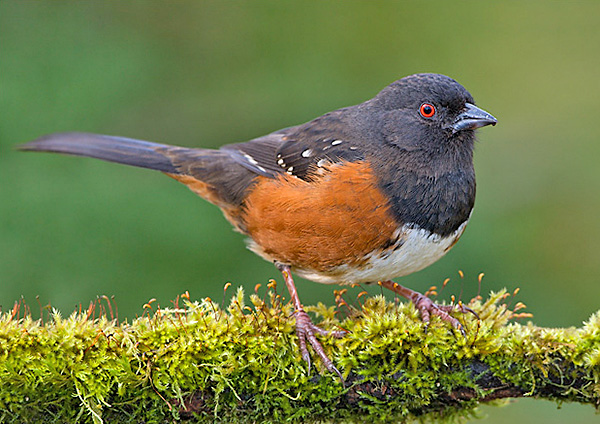
Photograph © Glenn Bartley.
Male Spotted Towhees have a coal-black tail, back, head, and throat. Their otherwise black wings have white wingbars which gives them their distinct spotted look. They have a white belly and rust-colored flanks.
Female Spotted Towhees look similar to males, but their colors are muted. Instead of black, their upperparts and throat are grayish brownish, and the rufous color on the flanks is a bit duller. If you see one flying, you can recognize one of these birds by the white corners of its black tail.
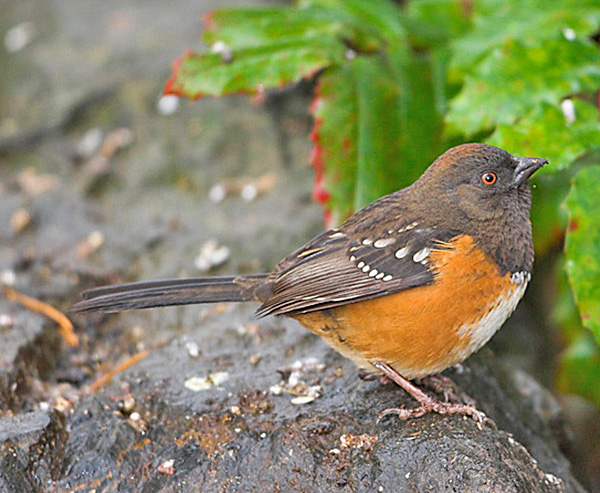
Female. Copyright Glenn Bartley
Juvenile Spotted Towhees are a patchwork of different shades of tan, brown, and pale buff. Their uppersides are warm chestnut brown, undersides tan with darker streaking, and wings and tail dark brown, almost black. Older but still immature individuals resemble females.
The spotted Towhee song sounds like a faster and less melodic version of the Eastern Towhee’s song. It starts with a few chirp notes and ends with a fast trill, lasting for about 1-2 seconds. Some birds only sing the trill.
Spotted Towhees have a few different calls. They have a high-pitched, thin, and a bit buzzy flight call, high and thin chips, and rasp cat-like mewing calls.
Food
Spotted Towhees are omnivores with their specific diet depending on the season. During the breeding season in spring and summer, they eat food rich in protein, mainly insects.
This includes ground beetles, ladybugs, millipedes, weevils, crickets, sowbugs, spiders, caterpillars, moths, bees, wasps, and wood-boring beetles. During fall and winter, their diet switches to be more plant-based. They eat different acorns, seeds, grains, and berries, including thistle, blackberry, raspberry, sumac, nightshade, oat, wheat, cherries, corn, poison oak, and buckwheat.
Spotted Towhees are ground-foraging birds that primarily search for food by rummaging through the leaf litter. While foraging, it follows a distinct movement pattern, whereby it hops backward, scratching up the leaves to uncover hidden insects and seeds, and then pounces forward if they spot food. They also glean insects from branches and foliage of low trees and thick shrubs.
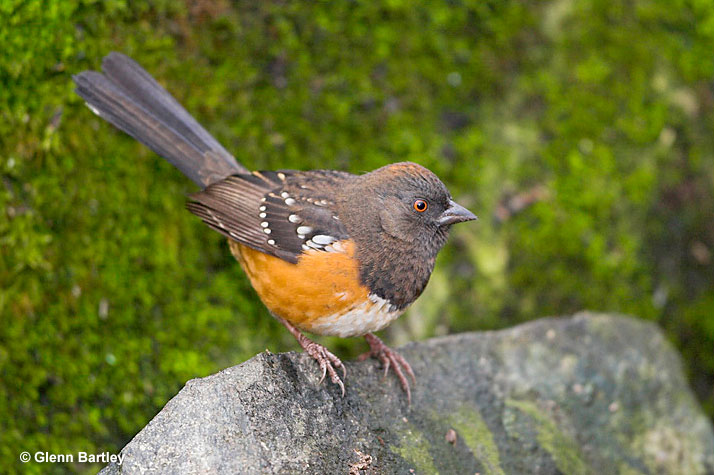
Nesting and Eggs
During the breeding season, Spotted Towhees are territorial and monogamous. The male defends his nesting territory by singing, which is often done from a high perch, and may pursue the female as a part of the courtship process.
Spotted Towhees nest on the ground under a shrub or in low brushes less than five feet off the ground. The nest is built by the female and is a cup made of twigs, grass, leaves, weeds, and strips of bark and is lined with finer materials, such as animal hair and conifer needles.
Nests built on the ground are usually located in depressions with the outer rim at ground level.
These birds may have up to three broods in a year with 2-6, mostly 3-5 eggs in a clutch. Spotted Towhee eggs can be pale gray, creamy white, or even pinkish, bluish, or greenish with brown, purple, gray, or reddish spots often concentrated at the larger end. The eggs are about an inch or less long and 0.7-0.8 inches wide.
The mother bird incubates the eggs by herself for 12-14 days. The male helps to take care of and feed the young after they’ve hatched. The offspring leave the nest 10-12 days after hatching, although they may stay with their parents for a bit longer.
Current Situation
Spotted Towhees range throughout the western part of North America with their range extending into southern Mexico. The birds are year-round residents in several states, including California, Arizona, Oregon, Nevada, Utah, Washington, Idaho, and southern British Columbia.
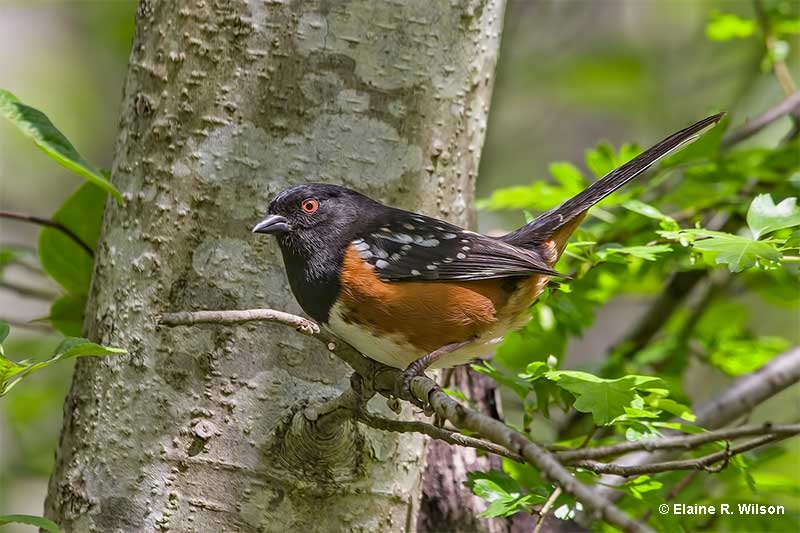
© Elaine R. Wilson
Their breeding range extends further north into southwestern Canada and their wintering range further south into Texas and southern Mexico. Birds from the northern areas migrate to southern areas for the winter.
Spotted Towhees prefer to inhabit brushy and shrubby areas. Depending on the location, you can meet them in thickets, dry upland forests, open forests with dense understory, chaparrals, old fields, and shrubby backyards – any place that has dense shrubs for cover and leaf litter to rummage around in.
The Spotted Towhee is listed as a species of least concern on the IUCN Red List. Currently, they have a stable population of 40 million mature individuals and not many threats. Their only problem is predation by snakes and cats.
Facts
- Spotted Towhees are very similar to Eastern Towhees and were previously considered to be the same species called the Rufous-sided Towhee. However, their range only overlaps in the Great Plains, where they also occasionally interbreed.
- Spotted Towhees sometimes sunbathe by lying down on the grass and spreading their feathers.
- As with other species, Spotted Towhees have conflicts. If you see two birds squabbling and then one of them picks up a piece of bark, twig, or leaf and carries it around, then this may be an indication that the bird surrendered.
- When trying to find a mate early in the breeding season, Spotted Towhees spend 70 to 90 percent of their mornings singing. After they’ve found a mate, they sing much less, only about 5 percent of the time.
- Instead of flying, female Spotted Towhees run away from the nest when disturbed.
Similar Species To Spotted Towhee
Spotted Towhees have quite a unique appearance which is why we only have two similar species on this list. However, read carefully since they are quite similar.
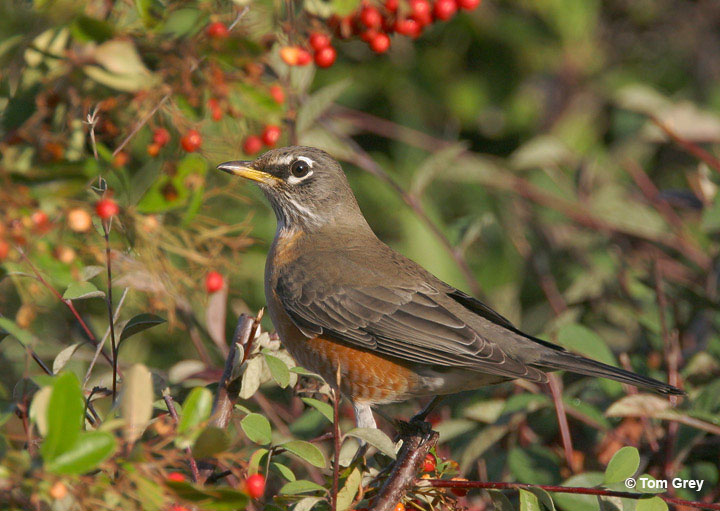
American Robin © Tom Grey
Although similar to Spotted Towhees, American Robins are slenderer, have yellow bills instead of black ones, and have white rings around their eyes.
Their undersides are almost entirely rufous.
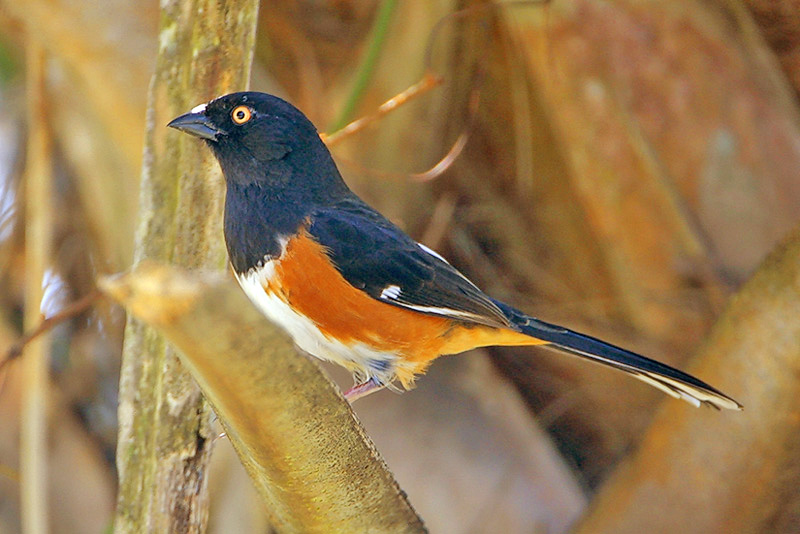
Eastern Towhee. Photograph © Greg Lavaty.
These two towhees are almost identical. You can identify which one you saw by location and how its wings looked. Eastern Towhees are found in the eastern part of the United States, whereas Spotted Towhees inhabit the western part of North America.
Male Eastern Towhees are almost solid black above with white patches on their wings, whereas Spotted Towhees have white spots on their wings.
Females are easier to tell apart. Female Spotted Towhees are dark grayish brownish above, whereas female Eastern Towhees’ uppersides are solid chestnut brown without the white spots on the wings.
Frequently Asked Questions
Why is it called a towhee?
Towhees are called after their most common call, which is a rising tow-hee or joree sound.
Are Spotted Towhees rare?
Spotted Towhees are widespread and very common within their range.
What does a Spotted Towhee sound like?
Spotted Towhee’s song consists of fast chirps with a trill at the end. Some calls may sound similar to a cat mewing.
What does a Spotted Towhee eat?
Spotted Towhees eat insects and other small invertebrates found in leaf litter during the breeding season and fruit, berries, seeds, and grains during the winter.

